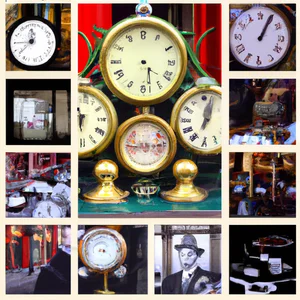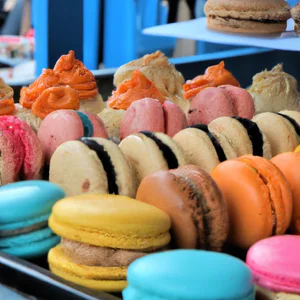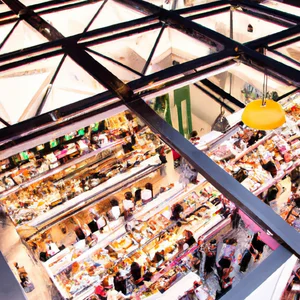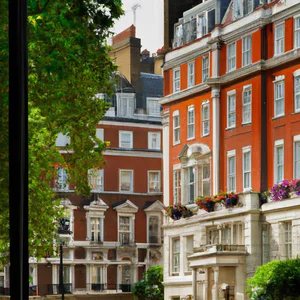Book your experience
Nordic cuisine in London: hygge and Scandinavian flavors in the capital
Nordic cuisine in London: a splash of hygge and Scandinavian flavors in the city
So, let’s talk a little about Nordic cuisine in London. It’s a topic that fascinates me, and not just because I love the concept of hygge, which is that sort of Danish cuddle, a warm hug in the cold winters. Every time I think of Scandinavian cuisine, I think of that feeling of sitting around a wooden table, with a cup of steaming tea in hand and maybe a slice of apple pie that smells of cinnamon. Well, this is exactly what you can breathe in the restaurants and cafes that I discovered around London.
There is a place, I don’t know if you’ve ever heard of it, called “Scandi Kitchen”. It’s small, but it has that warmth that makes you feel at home, as if you were in a cabin in Norway, even if you’re right in the center. There I tasted a smørrebrød for the first time, which is basically a slice of bread with various goodies on top. I tell you, it was like a work of art, with smoked salmon, avocado and a little dill. I don’t know, but every bite was like a trip to a Norwegian forest, fresh and invigorating.
And then there are Swedish meatballs, the ones everyone knows. But believe me, not all meatballs are the same! I tried making them at home once, and I assure you that the result was… well, let’s say they were more like bricks! But in these restaurants, they serve them with a blueberry sauce which is the icing on the cake. I swear, every time I taste them, I feel like I’m in a Wes Anderson film, all colorful and a little strange, but perfect.
In short, I don’t know if Nordic cuisine will ever have the same appeal as Italian or Indian cuisine here in London, but in my opinion it has its strengths. There is something magical in those simple dishes, but so rich in flavor, that manage to warm your heart. Perhaps it is their philosophy of life, which speaks of simplicity and connection with nature. And, by the way, don’t you want to dive into a nice plate of marinated herring with a craft beer? I do, every time!
So, if you happen to be passing through London, don’t miss these Scandinavian gems. Maybe it will make you say: “Damn, these flavors are so good!” And who knows, you might even discover a new way to enjoy life, a little at a time, savoring every bite.
Discover the most authentic Nordic restaurants in London
When I first set foot in a Nordic restaurant in London, I didn’t know what to expect. The warm and enveloping light of the room, decorated with light wood and plants, immediately transported me to an atmosphere that seemed like a refuge in the heart of Scandinavia. Sitting at the table, I ordered a plate of smørrebrød, the classic Danish open sandwich, and I realized that Nordic cuisine is not just a set of ingredients, but a real way of life that celebrates simplicity and freshness.
Restaurants not to be missed
London offers a myriad of authentic Nordic restaurants that are worth exploring. Among the most renowned, Noble Rot is famous for its fresh fish and its innovative proposals, while Aster, which combines Scandinavian and French cuisine, is the ideal place for an elegant evening. Don’t forget Scandi Kitchen, a welcoming café where you can enjoy specialties such as cinnamon buns and fika, the traditional Swedish break.
For an even more authentic and little-known experience, I recommend you visit Vete-Katten, a historic Swedish pastry shop that opened its doors in 1928. Here, in addition to enjoying exquisite desserts, you can immerse yourself in an atmosphere that it seems like something out of a fairytale book, with its vintage furnishings and the scent of freshly brewed coffee.
Culture and history
Nordic cuisine in London is the result of a cultural fusion that dates back centuries, when Scandinavian merchants began trading goods and ingredients with the English. Today, this tradition lives on through restaurants, where dishes like gravadlax and Danish sausages tell stories of a shared past.
Sustainability in the kitchen
Many Nordic restaurants in London are embracing sustainable cooking practices, using local and seasonal ingredients. This approach not only reduces environmental impact, but also celebrates the richness of British produce. Be sure to ask the staff about where the ingredients come from; most will be happy to share their eco-friendly philosophy.
An invitation to explore
If you are looking for a unique activity, why not join a Nordic cooking workshop? Several restaurants offer courses to learn how to prepare traditional dishes, such as the famous Swedish meatballs. This experience will not only teach you new recipes, but will also allow you to connect with London’s Nordic community.
We often think that Nordic cuisine is limited to simple and not very tasty dishes, but in reality it is a sensorial journey full of aromas and fresh ingredients. Next time you’re in London, don’t miss the chance to discover these Nordic restaurants - who knows, you might find a new favorite dish!
How about trying a smørrebrød or a delicious Swedish cake? What is the Nordic dish that intrigues you the most?
The hygge philosophy: how to experience Scandinavian comfort
An encounter with comfort
On a cold London evening, I found myself in a cozy Islington cafe, surrounded by soft lights and the enveloping aroma of freshly baked apple pie. While sipping hot tea, I realized I was experiencing a moment of hygge, the Danish philosophy that celebrates comfort, conviviality and simplicity. That little corner of happiness opened my eyes to how London, with its cultural diversity, also embraces this Scandinavian practice, inviting visitors to discover the warmth and welcome typical of Nordic countries.
A dive into the world of hygge
To experience hygge in London, you don’t just need coffee and cake, but also hands-on experiences. Restaurants like Scandi Kitchen in the heart of Bloomsbury offer a menu that highlights Nordic specialties in an intimate, relaxed setting. Here, you can savor a slice of kanelbullar (cinnamon buns) while chatting with friends or simply enjoying a quiet moment. According to their website, the restaurant’s philosophy is to create a space where every visitor can feel at home, a fundamental principle of hygge.
An insider tip
Unconventional advice? Don’t limit yourself to tasting the typical dishes. Try attending one of the hygge evenings organized in some restaurants, where you can share stories, games and, of course, food. This is a wonderful way to immerse yourself in Scandinavian culture, making your experience even more authentic.
The cultural impact of hygge
Hygge is not just a trend, but a way of life that has deep roots in Scandinavian culture. Its diffusion in London demonstrates how the traditions of a country can influence lifestyles in modern urban contexts. This embrace of comfort and community is a response to the frenetic pace of metropolitan life, offering Londoners and visitors a haven of serenity.
Sustainability and hygge
Many restaurants that embrace the concept of hygge are also committed to sustainable practices. For example, some use organic and local ingredients, reducing environmental impact. By choosing to eat in these places, you not only give yourself a moment of hygge, but you also contribute to responsible tourism.
An invitation to comfort
Imagine spending an evening in a cozy retreat, wrapped in a wool blanket, enjoying a hot chocolate and listening to the crackling of the fireplace. This is the heart of hygge. For an unforgettable experience, I recommend booking a table at The Nordic Bakery, where the warm atmosphere and fresh desserts will make you feel part of a world that celebrates simplicity and conviviality.
Myths and misconceptions
A common misconception is that hygge is only for winter or dinner at home. In fact, it’s a mindset that can be adopted in any season and in any environment. That’s the beauty of this philosophy: hygge can be found anywhere, even in a crowded London cafe.
A final reflection
Next time you find yourself in a Nordic restaurant or café, ask yourself: How can I incorporate a little hygge into my daily life? Whether it’s a chat with a friend or a moment of solitude with a good book, Scandinavian comfort is at your fingertips, ready to transform even the most ordinary days into extraordinary experiences.
Typical dishes: savor the Danish sausage and smoked fish
A memory of Nordic flavors
The first time I tasted a Danish sausage in London was in a little corner of Nørrebro, a restaurant that looked like it came out of a Scandinavian postcard. I remember the smoky aroma wafting through the air, while the waiter with a genuine smile explained the story of each dish to us. The sausage, prepared according to a traditional family recipe, was served with sauerkraut and mustard, a combination that exploded a mix of flavors that made me feel like I was in Denmark, not far from home.
Where to find the best of these dishes
In London, the Nordic dining scene is constantly growing and offers numerous restaurants that celebrate Scandinavian cuisine. Places like The Nordic Bakery and ScandiKitchen are great choices for those looking for authentic dishes like Danish sausage and smoked fish, a staple of Nordic cuisine. At Nordic Bakery, for example, smoked fish is prepared using traditional methods and served with fresh rye bread, a great option for a brunch or quick lunch.
An insider tip
A little-known tip is not to limit yourself to well-known restaurants. Some of the best local dishes can be found at food markets, such as Borough Market, where small stands offer artisanal sausages and high-quality smoked fish. Here, food artisans are often eager to share their stories and preparation methods, making the experience even more authentic.
A deep cultural bond
The tradition of eating sausages and smoked fish in Scandinavia dates back centuries, when communities had to preserve food for the long winters. These dishes are not just gastronomic delights, but tales of cultural resilience and the ability to adapt to environmental challenges. In London, this tradition continues to thrive, allowing anyone to immerse themselves in Nordic culture without having to travel.
Sustainability and responsibility
Many Nordic restaurants in London are committed to sustainable practices, using local ingredients and eco-friendly cooking methods. It is important to make informed choices, preferring those places that respect the environment and support local producers. This not only enriches our dining experience, but also helps to preserve the authenticity of Nordic cuisine.
An experience not to be missed
If you’re up for a culinary adventure, I recommend taking part in a smoked fish tasting at one of the specialty restaurants. Not only will you have the opportunity to taste some of the best Nordic dishes, but you will also be able to learn smoking techniques directly from the chefs.
Myths and misconceptions
Many think that Nordic cuisine is monotonous or too simple. In reality, it is an explosion of flavors and techniques that reflect the richness of Scandinavian nature. The variety of ingredients and surprising combinations can challenge even the most demanding palates.
A reflection
Have you ever wondered how food can tell stories of distant cultures? Every bite of Danish sausage or smoked fish is a piece of history, a link with the traditions of a people. The next time you enjoy a Nordic dish, take a moment to reflect on what it represents and the impact cuisine has on connecting us to the world.
Food markets: where to find fresh Nordic ingredients
A unique experience among Nordic flavors
I vividly remember the day I visited Borough Market in London, driven by the desire to discover fresh Nordic ingredients. As I wandered through the stalls, the scent of smoked fish and Nordic spices mixed with the crisp air, and the vibrant atmosphere of the market was contagious. In that moment, I understood that London is not only a cosmopolitan metropolis, but also a crossroads of culinary cultures, where Nordic flavors find a place of honour.
Where to find fresh, authentic ingredients
If you’re looking for fresh Nordic ingredients, there are several markets worth a visit. Borough Market is undoubtedly the most famous, but don’t forget to explore Camden Market and Brixton Village. These places offer a wide range of products, from fresh fish and Danish sausages to Scandinavian herbs and spices. Some suppliers, such as Nordic Bakery, also sell Swedish baked goods, such as the famous rye bread, perfect for a light lunch.
An insider tip
A little-known tip is to visit the markets during the week, rather than on the weekend. Not only will you find fewer crowds, but you’ll also have the opportunity to chat with the vendors, who are often passionate about Nordic cuisine and ready to share secret recipes or tips on how to best use fresh ingredients.
The cultural impact of food markets
London’s food markets are a reflection of its cultural diversity. As interest in Nordic cuisine has increased, many vendors have begun to include Scandinavian specialties in their offerings. This not only enriches the city’s culinary landscape, but also promotes a cultural dialogue between culinary traditions.
Sustainability and responsible purchasing
Many of London’s markets, including Borough and Camden, are committed to sustainable practices. Choosing fresh, local ingredients not only reduces your environmental impact, but also supports local producers. Look for suppliers who offer seasonal and organic products, for a more responsible dining experience.
A lively and engaging atmosphere
Imagine strolling through the stalls, as the sun filters through the colorful curtains and the sounds of chatter and laughter fill the air. Every corner is an invitation to discover new culinary delights, and you feel part of a vibrant community that celebrates food and culture.
An experience not to be missed
I encourage anyone visiting London to take part in a Nordic cooking workshop, where you can learn to prepare typical dishes with fresh ingredients purchased directly from the market. Some courses, such as those organized by The Cookery School, offer hands-on experiences that combine culinary art with learning about Scandinavian traditions.
Let’s face the myths
A common misconception is that Nordic cuisine is monotonous or not very tasty. In fact, the variety of fresh ingredients and the use of preservation techniques, such as smoking and fermentation, create dishes rich in flavor and complexity.
A final reflection
As you explore London’s food markets, I invite you to reflect on how interconnected food and culture are. Which Nordic flavors will you take home with you? Your culinary adventure in London could be just the beginning of an enduring love for Nordic cuisine.
Sustainability in the kitchen: eco-friendly restaurants in London
An enlightening discovery
During one of my walks in the lively neighborhood of Hackney, I came across a small restaurant called “The Green Fork”. The atmosphere was warm and welcoming, with plants adorning every corner and a menu that boasted strictly organic and local ingredients. As I savored a delicious bowl of pea and mint soup, the owner told me about his vision for a restaurant that not only nourishes, but also respects the planet. This encounter opened my eyes to London’s growing eco-friendly food scene, where food is prepared with an eco-consciousness and a passion for sustainability.
Restaurants not to be missed
London is a real hub for sustainable restaurants, with a variety of options that embrace the ‘zero kilometre’ philosophy and the use of seasonal ingredients. Here are some of the best eco-friendly restaurants to explore:
- Moro: Located in Exmouth Market, this restaurant offers dishes inspired by Mediterranean cuisine, using organic and sustainable ingredients.
- Silo: In Hackney, Silo is the world’s first zero-waste restaurant, where every ingredient is used intelligently and nothing is wasted.
- Farmacy: This restaurant in Notting Hill focuses on plant-based eating and offers dishes prepared with fresh, organic ingredients.
An insider tip
A little-known tip is to look for sustainable restaurant “pop-ups”. These temporary dining experiences not only offer innovative dishes, but often collaborate with local producers to ensure fresh, farm-to-table ingredients. Attending one of these events can turn into a unique gastronomic adventure, where you can also meet the chefs and learn more about their culinary philosophy.
The cultural impact
The growing focus on sustainability in London’s restaurants reflects a wider cultural shift, where consumers are becoming increasingly aware of the impact of their food choices. Sustainable cooking is not just a trend; it’s a movement that’s reshaping the way we think about food and our health. This approach has historical roots in Nordic traditions, where connection with nature and respect for resources have always been fundamental values.
Sustainable tourism practices
When exploring London’s eco-friendly food scene, also consider the impact of your choices. Opt for restaurants that use sustainable practices, reduce waste and partner with local farmers. This not only helps the environment, but also supports the local economy and communities.
A sensory immersion
Imagine sitting in a restaurant that smells of fresh herbs, with the sound of dishes mixing and the laughter of diners filling the air. Every dish you taste tells a story, from the origins of the ingredients to the passion of the chefs. London’s sustainable food scene isn’t just about meals; it is an experience that invites us to reflect on how our way of eating can influence the world around us.
Activities to try
For a hands-on experience, I recommend taking part in a sustainable cooking workshop. Many eco-friendly restaurants offer courses where you can learn to prepare delicious dishes using local and organic ingredients. It will be a fun and educational way to get closer to the philosophy of sustainability in the kitchen.
Myths to dispel
A common misconception is that sustainable food is always more expensive or less tasty. In fact, many eco-friendly restaurants offer delicious dishes at affordable prices, proving that it is possible to eat well without compromising our planet. Sustainability is not just a question of budget, but of conscious choices.
Final reflection
Have you ever considered how your food choices can have a direct impact on the environment? As you explore London’s eco-friendly restaurants, I invite you to reflect on how the way you eat can contribute to a more sustainable future. The next time you sit at the table, ask yourself: what story does my dish want to tell?
Culinary events: Nordic festivals not to be missed
I vividly remember my first experience at the Nordic Food Festival in London, an event that transformed a corner of the city into a vibrant marketplace of flavors and colours. As I strolled through the stalls, the scent of grilled Danish sausage mixed with that of smoked fish, creating an atmosphere of conviviality and discovery. Every year, this festival attracts cooking enthusiasts and curious people, united by a passion for Scandinavian culinary traditions.
A taste of Nordic culture
London hosts several culinary events that celebrate the rich food culture of the Nordic countries. Among the best known, the Scandi Kitchen Christmas Market offers an unmissable opportunity to taste typical dishes such as glögg (Swedish mulled wine) and pepparkakor (spiced biscuits). This market is held in the heart of London every December and represents a perfect fusion between the Christmas holidays and Scandinavian culinary traditions.
Insider tip: Many don’t know that at the Nordic Food Festival it is possible to participate in cooking workshops where you can learn the preparation techniques of surströmming, the famous Swedish fermented fish. It is an experience that challenges the senses and a unique way to immerse yourself in the gastronomic culture of the north.
A profound cultural impact
The presence of Nordic festivals in London is not just about food; it’s a way to celebrate the Scandinavian communities living in the British capital. These events serve as a cultural bridge, uniting people of different backgrounds through food and tradition. The growing interest in Nordic cuisine is also a reflection of the growing attention towards sustainability, an intrinsic aspect of Scandinavian food practices.
An experience worth living
If you find yourself in London during one of these events, don’t miss the chance to attend one of the craft beer tastings. Scandinavian beers, often produced with local ingredients and traditional methods, offer a unique sensorial experience, perfect for accompanying typical dishes.
Myths to dispel
A common misconception about Nordic cuisine is that it is simple and not very tasty dishes. In reality, Scandinavian cuisine is characterized by a variety of complex flavors and refined preparation techniques, ranging from smoking, fermentation and the use of fresh, local ingredients.
In conclusion, attending a Nordic festival in London is not just an opportunity to delight your palate, but an invitation to explore the beauty of Scandinavian culinary traditions. Have you ever thought about how food can unite cultures and people? The next time you taste a Nordic dish, remember that behind every bite there is a story to tell.
A journey through Scandinavian culinary traditions
I still remember my first bite of smørrebrød in a small restaurant in Copenhagen, an experience that opened my eyes to the richness of Scandinavian culinary traditions. That rye bread, topped with smoked fish and garnished with red onions and dill, was more than just a meal; it was a journey into the heart of Nordic culture. Today, in London, this tradition is lived in an equally authentic way, thanks to a lively and passionate community.
Discovering culinary roots
Nordic restaurants in London aren’t just places to eat; they are spaces where traditions intertwine with modernity. From Lille Kitchen to Islington, where the menu reflects the seasons and the use of fresh ingredients, to Nordic Bakery, famous for its pastries and coffee, each location tells a story. Local sources such as Time Out and the Evening Standard offer exceptional insights into the city’s most authentic restaurants, making food research a pleasure.
An insider tip
If you want a truly unique experience, try visiting Mikkeller Bar in Camden, where you can taste a selection of Danish craft beers accompanied by traditional Scandinavian-inspired dishes. Here, you’ll not only savor unique flavors, but also converse with locals, who often share fascinating stories about how food and culture intersect in their daily lives.
The cultural impact
Scandinavian cuisine in London is not just a reflection of a diet, but a celebration of values such as sustainability and respect for the environment. Traditions such as gathering herbs and mushrooms, and using local ingredients, are practices that reflect a way of life that is gaining more and more supporters. This approach not only enriches gastronomy, but also promotes responsible tourism.
Immerse yourself in the atmosphere
Imagine entering a restaurant decorated with light wood and pastel shades, where the scent of smoked fish mixes with that of fresh bread. It is an environment that invites conviviality, where each dish is prepared with care and attention to detail. Conviviality is a fundamental aspect of Scandinavian culture, and London restaurants capture this essence perfectly.
Try the experience
For total immersion in Nordic culinary culture, sign up for a Scandinavian cooking course at The Cookery School in London. Here, you can learn traditional techniques and recipe secrets, bringing home not only flavours, but also stories and knowledge.
Debunking myths and prejudices
A common misconception is that Scandinavian cuisine is monotonous or uncreative. Instead, it is a fusion of fresh flavors and innovative techniques, continually evolving to reflect modern influences, whilst remaining rooted in traditions.
Final reflection
As you explore Scandinavian culinary traditions in London, ask yourself: How can I integrate these values of sustainability and conviviality into my daily life? Every dish tells a story and every restaurant is an invitation to discover a way of life that celebrates comfort, quality and respect for nature. Such a trip is not just gastronomic, but a real life experience.
Coffee and sweets: a taste of Swedish fika
Imagine walking through the cobbled streets of London, with the scent of fresh coffee mixing with the crisp autumn air. You stop in a welcoming Nordic café, where the warmth of the wood and soft lights create an intimate atmosphere. Here, the coffee break is not just a moment of refreshment, but a celebration of conviviality and sweetness that perfectly embodies the Swedish philosophy of fika. This ritual, which includes a coffee accompanied by delicious desserts, is an invitation to slow down and enjoy the small pleasures of life.
The tradition of fika
fika has deep roots in Swedish culture and represents much more than a simple coffee break. It’s a time of connection, where friends, family and colleagues come together to share stories and smiles. In recent years, London has seen a proliferation of cafés and patisseries offering an authentic fika experience, with desserts such as kanelbullar (cinnamon roll) and princesstårta (prince cake), which not only delight the palate but also tell a story of tradition and passion.
Where to find the best Nordic coffees
If you want to immerse yourself in this sweet tradition, you can’t miss places like Fika in Clerkenwell or ScandiKitchen in Earls Court. Both locations offer a selection of fine coffees and fresh Swedish pastries, prepared with local and sustainable ingredients. Furthermore, the staff, often of Nordic origins, is always ready to share anecdotes and curiosities about the tradition of fika.
An insider tip
A little secret? Don’t limit yourself to just ordering coffee and desserts; also ask to try the chokladbollar, a delicious chocolate and coconut ball, often forgotten by non-Swedes. This delicacy is an absolute must and will make you feel like you’re sitting in a Stockholm cafe.
The cultural impact of fika
The fika is not just a moment of pause; it is a reflection of a culture that places great emphasis on well-being and time spent together. In a world where everything runs fast, taking a moment to slow down and appreciate the present is a precious gift. London, with its multiculturalism, has welcomed this practice, contributing to a wider dialogue on eating and social habits.
Sustainability in the Nordic tradition
Nordic cafes in London are also committed to sustainability, using organic and local ingredients, and often partner with producers who follow eco-friendly practices. This is a way to pay homage to the Scandinavian tradition, which is based on a deep respect for nature.
An activity not to be missed
For the full experience, take a Swedish cooking class. Many cafes offer workshops on the preparation of typical desserts, where you can learn how to make kanelbullar and, of course, how to serve the perfect coffee for an unforgettable fika.
Final reflections
Next time you need a break, remember that fika is more than just coffee; it’s a way to reconnect with yourself and others. We invite you to reflect on how you can incorporate this ritual into your daily life. Are you ready to discover the power of fika and bring a pinch of Scandinavian warmth into your routine?
Local experiences: Scandinavian cooking classes in the city
When I decided to deepen my knowledge of Nordic cuisine, I found a Scandinavian cooking class that promised to reveal the secrets of traditional recipes. The idea of kneading rye bread and making cinnamon cakes immediately caught my attention, and so I signed up. The location chosen, a small studio in the heart of Hackney, was welcoming and full of vintage kitchen tools, which gave the space a warm and relaxed atmosphere.
A practical and authentic experience
During the course, led by a passionate Swedish chef, I discovered not only how to prepare classic dishes such as Swedish meatballs and smoked salmon, but also the importance of the social bonds that these dishes represent in Scandinavian culture. It was fascinating to see how each recipe had a story to tell, reflecting a life philosophy that celebrates simplicity and connection with nature.
Practical information and recommended courses
Today, London offers numerous Nordic cooking courses, perfect for those who want to immerse themselves in this experience. Some of the best known include:
- Scandi Kitchen: In addition to being a restaurant, it also offers workshops to learn how to prepare typical dishes.
- The Cookery School at Little Portland Street: Here you can take part in Nordic cooking courses, where each lesson is accompanied by stories about Scandinavian culinary traditions.
- Nordic Bakery: This cafe chain organizes baking workshops, where you can learn how to make the famous Finnish rye bread.
An insider tip
One tip you won’t easily find online is to bring a notebook with you. During classes, chefs often share tricks and tips that are not written in official recipes. Writing down these pearls of wisdom will help you replicate the experience a home and impress your friends with your new cooking skills!
Cultural impact
Scandinavian cuisine in London is not just a gastronomic trend, but reflects the growing interest in wellbeing and sustainability. The simple dishes, but rich in flavour, tell stories of community and traditions that are intertwined with the modern life of the city.
Sustainability and responsibility
Many cooking classes are committed to using local and seasonal ingredients, encouraging sustainable practices. This approach not only supports local producers, but also allows you to enjoy fresh, authentic flavours.
Soak up the atmosphere
Imagine kneading cardamom-scented cakes, while the sun filters through the windows of the laboratory. The scent of cooking dishes fills the air, while the laughter and chatter of the other participants creates an atmosphere of conviviality. It’s a heart-warming experience, just like the concept of hygge.
Myths to dispel
We often think that Scandinavian cuisine is just fish and meatballs. In reality, it is a world full of unique flavors, colors and ingredients. From legume soups to fresh salads, there is much more to discover.
A final reflection
Are you ready to get your hands dirty and discover the secrets of Nordic cuisine? Taking a Scandinavian cooking class in London will not only allow you to learn new recipes, but will also give you the opportunity to connect with a culture that celebrates comfort and warmth. It is not just a culinary journey, but an invitation to reflect on how simplicity can enrich our lives. Which Scandinavian dish would you like to learn to cook?
The history of Nordic food: cultural influences in London
A taste of nostalgia
I still remember the first bite of a smørrebrød that I enjoyed in a small Danish restaurant in London. It was a rainy afternoon, and the warm and welcoming atmosphere of the place seemed to envelop me like a wool blanket. As the fork sank into the rye bread, the flavor of the smoked fish mixed with that of the horseradish cream, creating a combination of flavors that evoked the Nordic culinary tradition. This simple dish was not just a meal, but a journey through Scandinavian history and culture, a testament to how food can tell stories of distant lands.
A crossroads of cultures
The history of Nordic food in London is intertwined with immigration and cultural influences that have manifested themselves over the years. In recent decades, the British capital has seen a growing affirmation of Scandinavian cuisine, thanks to the arrival of chefs and restaurateurs from countries such as Denmark, Sweden and Norway. Restaurants like Noma have pioneered a new era of dining, while smaller venues like Scandi Kitchen have brought traditional dishes to the forefront, making them accessible to a wider audience.
An insider tip
If you want an authentic Nordic dining experience, I recommend visiting London’s food markets, such as Borough Market or Boxpark Shoreditch, where you can find fresh ingredients and Nordic specialities. A little secret? Don’t miss the smoked fish counter and the Danish cheeses: they are a real treasure for those who love intense and authentic flavours.
Food as history
Each dish tells a story. The Scandinavian culinary tradition is strongly linked to geography and climate, where fish and game have always had a central role. Viking influence, for example, led to food preservation practices such as salting and smoking, which today form the basis of many dishes served in London restaurants. These methods not only preserve food, but also enhance its flavors, creating a direct link with the past.
Sustainability and responsibility
The growing focus on sustainability has also influenced Nordic cuisine in London. Many restaurants are committed to using local and seasonal ingredients, thus reducing environmental impact and supporting local producers. An example is The Nordic Bakery, which promotes an eco-friendly approach, not only in their dishes, but also in the choice of suppliers.
An immersive experience
For a unique experience, try taking a Nordic cooking class, where you can learn to make traditional dishes like gravlax or Swedish meatballs. These activities will not only allow you to hone your culinary skills, but will also provide you with an opportunity to immerse yourself in Nordic culture.
Myths to dispel
A common misconception is that Nordic cuisine is monotonous or not very tasty. In fact, the variety of fresh ingredients and preparation techniques make each dish a sensory experience. Scandinavian cuisine is a perfect balance of flavors, ranging from sweet to savory, from fresh to smoked.
Final reflection
Next time you sit down at a Nordic restaurant in London, take a moment to think about how history and culture influence what we eat. As every bite tells a story, what other culinary traditions await us to be discovered in the heart of the city?

 Architecture and Design
Architecture and Design Cities and Regions
Cities and Regions Culture and History
Culture and History Events and Festivals
Events and Festivals Fashion and Shopping
Fashion and Shopping Food and Wine
Food and Wine Nature and Adventure
Nature and Adventure Unique Experiences
Unique Experiences



























